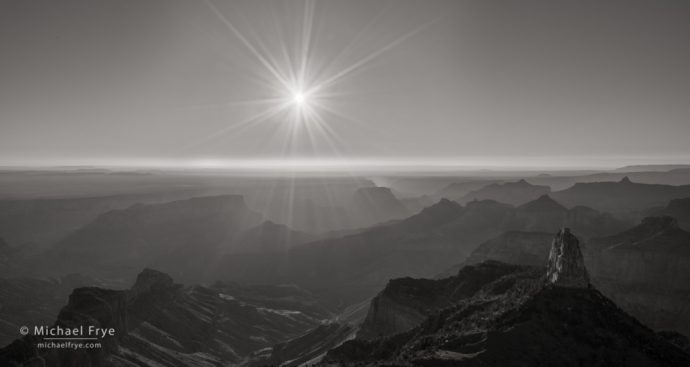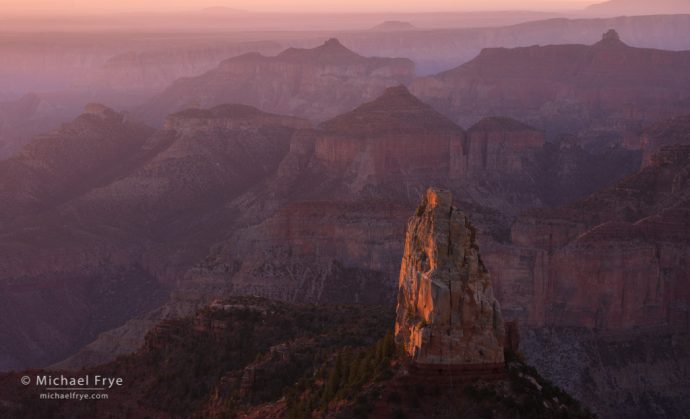
Morning sunlight from the North Rim of the Grand Canyon, Arizona. I used the “thumb technique” to reduce flare in this image; see the post for more details.
On our road trip last month Claudia and I found ourselves in Kanab, Utah. We cooked breakfast at a picnic table in a small park in town, and discussed our next move. There are a lot of options from Kanab. Should we head to Zion? Detour east toward the Paria River area? Drive the Cottonwood Canyon Road?
And then I thought, we’re pretty close to the North Rim of the Grand Canyon. And neither of us had ever been there. So the North Rim it was.
The campground inside the national park was closed, but we managed to grab one of the last sites in the nearest campground outside the park. Then we drove into the park and spent the waning hours of the day checking out some of the viewpoints.
We were just exploring, and I didn’t have any grand photographic plans. There wasn’t any interesting weather in the forecast – not even some clouds. And most of the better photographs I’ve seen from the rim of the Grand Canyon were from the South Rim. Even though the North Rim is higher in elevation, the drop off into the canyon from the South Rim is more abrupt, and perhaps more dramatic.
But I was quite taken with the North Rim. It’s more remote, less developed, and therefore less crowded. There were people – it’s a well-known national park, after all – but not many. It felt peaceful.
And although the gradient from the North Rim into the canyon isn’t as abrupt as it is from the South Rim, there are lots of terraces and mesas to work with, and it seemed like there were some interesting possibilities for compositions.
While we didn’t see any clouds, we did find haze from distant fires. And I actually loved that. The haze added a misty, ethereal look to the scenes, and added to the sense of depth.
The next morning we rose early and drove back into the park. We headed for Point Imperial because I thought the rock formations from that viewpoint would catch the early-morning sun. Which they did:
As the sun rose higher I kept photographing, and found myself drawn to the view directly toward the sun. The problem was that I knew the sun would create some strong flare. So I used the “thumb technique.” That is, I took a normal series of auto-bracketed exposures (bracketed because the contrast was so extreme), then stuck my thumb out in front of the camera to block the sun from the top part of the frame, and took another auto-bracketed sequence. (If that’s hard to visualize, I describe this technique in detail in an earlier post.)
Later, I blended both auto-bracketed sequences with Lightroom’s HDR Merge, then took those two merged images into Photoshop, where I used a layer mask to combine them. Most of the final photograph is from the second sequence, where my thumb blocked the sun and dimmed the flare. But the part around the sun itself is from the first sequence.
The final image at the top of this post has a sun star, but minimal flare – just what I was looking for. And I like the sense of depth created by the haze and the distant horizon.
I’m glad we made that little detour to the North Rim. I ended up making some photographs I liked, but even better, we got to experience this wonderful landscape from a different perspective.
— Michael Frye
P.S. There’s still time to get a discount on my new course, Landscapes in Lightroom: Advanced Techniques! Use the code FALL2020 to get 20% off until midnight on Wednesday.
Related Posts: When a Scene Composes Itself; Land of Dinosaurs
Michael Frye is a professional photographer specializing in landscapes and nature. He is the author or principal photographer of The Photographer’s Guide to Yosemite, Yosemite Meditations, Yosemite Meditations for Women, Yosemite Meditations for Adventurers, and Digital Landscape Photography: In the Footsteps of Ansel Adams and the Great Masters. He has also written three eBooks: Light & Land: Landscapes in the Digital Darkroom, Exposure for Outdoor Photography, and Landscapes in Lightroom: The Essential Step-by-Step Guide. Michael has written numerous magazine articles on the art and technique of photography, and his images have been published in over thirty countries around the world. Michael has lived either in or near Yosemite National Park since 1983, currently residing just outside the park in Mariposa, California.










Glad you got to see the north rim, Michael. It’s a beautiful place. I love the photos you captured.
Thanks John!
Grand Canyon seens beautiful in every Rim… I didn’t know North Rim, but I can’t describe in words the fellings and emotions when a saw the south rim…these colors were so real! Did you you have photographs of South Rim Michael? Im a huge fan of your work, from Brazil.
Thanks Evandro. I have photographed the South Rim, but a long time ago. I’ve also rafted down the canyon, which was an amazing experience.
Huh, interesting. I must have missed the thumb technique before. Thanks for sharing it. We’ve been to the north rim once and really liked it there. We haven’t been to the south rim. We chose the north rim because it is less crowded.
I really like the monochromatic processing on that shot. It adds some mystery for me.
Thanks Doug, and I hope you’re able to put the thumb technique to good use!